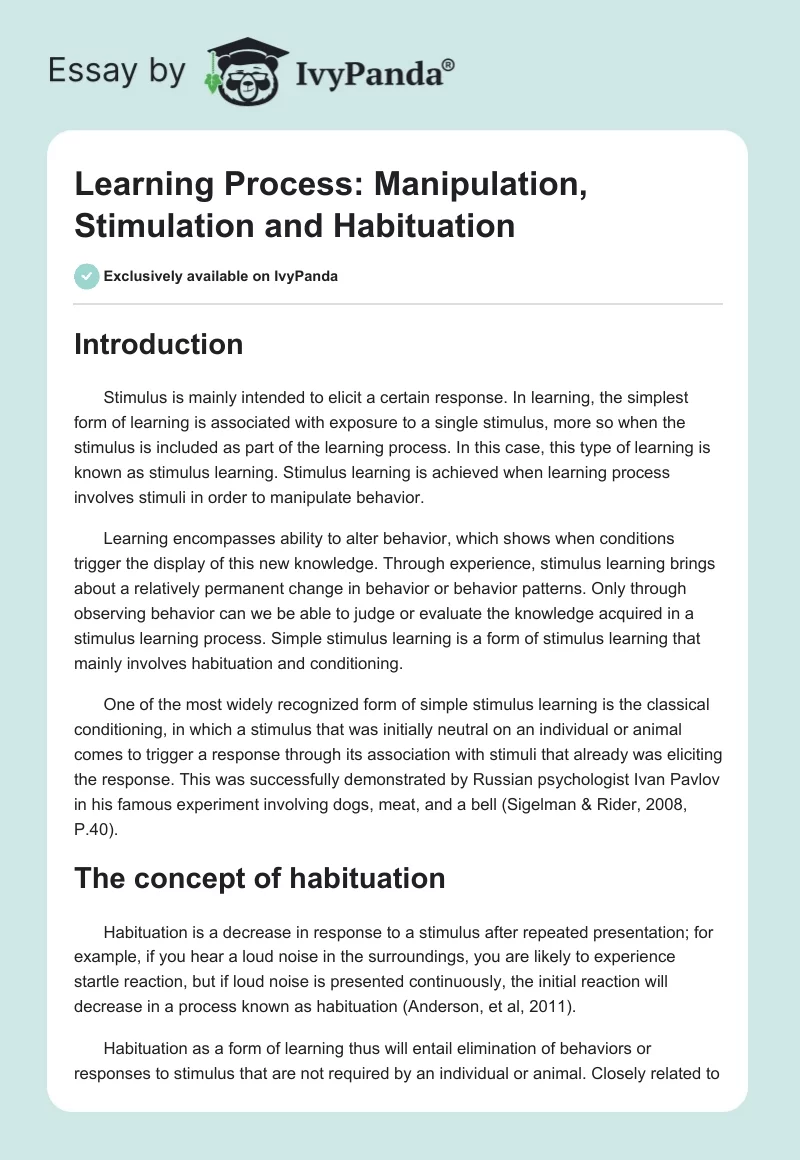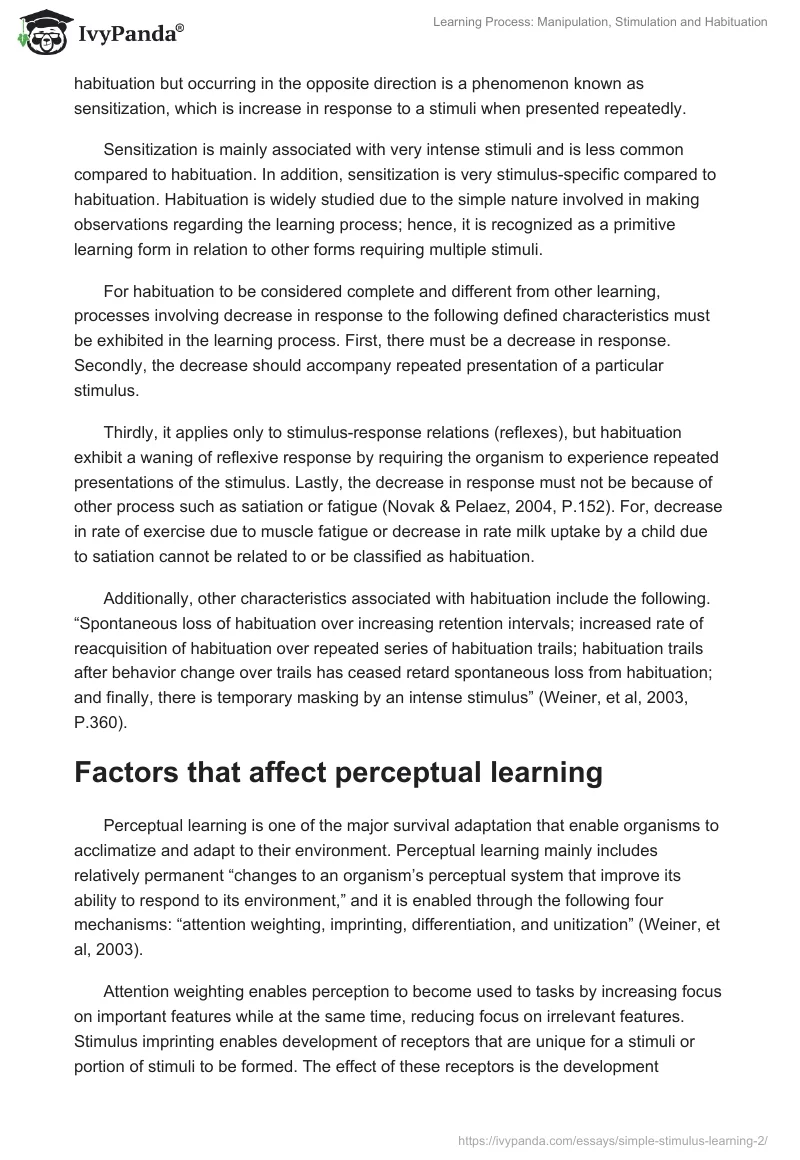Introduction
Stimulus is mainly intended to elicit a certain response. In learning, the simplest form of learning is associated with exposure to a single stimulus, more so when the stimulus is included as part of the learning process. In this case, this type of learning is known as stimulus learning. Stimulus learning is achieved when learning process involves stimuli in order to manipulate behavior.
Learning encompasses ability to alter behavior, which shows when conditions trigger the display of this new knowledge. Through experience, stimulus learning brings about a relatively permanent change in behavior or behavior patterns. Only through observing behavior can we be able to judge or evaluate the knowledge acquired in a stimulus learning process. Simple stimulus learning is a form of stimulus learning that mainly involves habituation and conditioning.
One of the most widely recognized form of simple stimulus learning is the classical conditioning, in which a stimulus that was initially neutral on an individual or animal comes to trigger a response through its association with stimuli that already was eliciting the response. This was successfully demonstrated by Russian psychologist Ivan Pavlov in his famous experiment involving dogs, meat, and a bell (Sigelman & Rider, 2008, P.40).
The concept of habituation
Habituation is a decrease in response to a stimulus after repeated presentation; for example, if you hear a loud noise in the surroundings, you are likely to experience startle reaction, but if loud noise is presented continuously, the initial reaction will decrease in a process known as habituation (Anderson, et al, 2011).
Habituation as a form of learning thus will entail elimination of behaviors or responses to stimulus that are not required by an individual or animal. Closely related to habituation but occurring in the opposite direction is a phenomenon known as sensitization, which is increase in response to a stimuli when presented repeatedly.
Sensitization is mainly associated with very intense stimuli and is less common compared to habituation. In addition, sensitization is very stimulus-specific compared to habituation. Habituation is widely studied due to the simple nature involved in making observations regarding the learning process; hence, it is recognized as a primitive learning form in relation to other forms requiring multiple stimuli.
For habituation to be considered complete and different from other learning, processes involving decrease in response to the following defined characteristics must be exhibited in the learning process. First, there must be a decrease in response. Secondly, the decrease should accompany repeated presentation of a particular stimulus.
Thirdly, it applies only to stimulus-response relations (reflexes), but habituation exhibit a waning of reflexive response by requiring the organism to experience repeated presentations of the stimulus. Lastly, the decrease in response must not be because of other process such as satiation or fatigue (Novak & Pelaez, 2004, P.152). For, decrease in rate of exercise due to muscle fatigue or decrease in rate milk uptake by a child due to satiation cannot be related to or be classified as habituation.
Additionally, other characteristics associated with habituation include the following. “Spontaneous loss of habituation over increasing retention intervals; increased rate of reacquisition of habituation over repeated series of habituation trails; habituation trails after behavior change over trails has ceased retard spontaneous loss from habituation; and finally, there is temporary masking by an intense stimulus” (Weiner, et al, 2003, P.360).
Factors that affect perceptual learning
Perceptual learning is one of the major survival adaptation that enable organisms to acclimatize and adapt to their environment. Perceptual learning mainly includes relatively permanent “changes to an organism’s perceptual system that improve its ability to respond to its environment,” and it is enabled through the following four mechanisms: “attention weighting, imprinting, differentiation, and unitization” (Weiner, et al, 2003).
Attention weighting enables perception to become used to tasks by increasing focus on important features while at the same time, reducing focus on irrelevant features. Stimulus imprinting enables development of receptors that are unique for a stimuli or portion of stimuli to be formed. The effect of these receptors is the development recurring stimuli, which occur in succession and with a lot of vigor and high frequency. Stimulus imprinting is of three types: whole stimulus imprinting, feature imprinting, and topological imprinting.
Whole stimulus enables imprinting of the whole stimuli, unlike feature imprinting, which enables the perceptual mechanism to identify only parts of a stimulus, which can be retrieved based on their prevalence; however, topological imprinting enables, through training, selection and matching of spaces and the position of patterns located in the space after recognition (Honey & Bateson, 1996).
Differentiation enables stimuli that were once joined to become separated and the components to be identified separately. Differentiation can be whole, categorical, or dimensional. Unitization enables tasks that were previously perceived as separate units to be detected as a complete single object. Moreover, perceptual learning is affected by a variety of factors; they include presenting of contrasting stimuli, change from an easy to a difficult stimuli, and attention and feedback processes (Honey & Bateson, 1996).
The effects stimulus exposure
The effects of stimulus exposure on a subject are varied but there have been some observed patterns or perceptions. Studies have shown that, with increasing rate of exposure to the stimulus, the attitudes towards a stimulus may become more appealing to the subjects, mainly due to the higher-order cognition involved, belief formation, a combination of positive habituation, boredom, and notions of implicit cognition through perpetual learning (Fiske, Gilbert & Lindzey, 2009, P.403). Stimulus exposure can also produce effect on subjects through priming facilitation.
Priming involves one presentation of a stimulus facilitating processing of a closely related stimulus following repetition of the same or a related stimulus that leads to the stimulus being primed, enabling easier identification and response to the stimuli (Homer & Henson, 2009). For example, if several images of a car are shown to a person in a rapid succession, and then shown as a mixture of images with that of the car included, it will be easier to identify the car from the mixture.
Additionally, in perceptual learning expectations may play a vital role in generation of affective and emotions reactions. Expectations can lead to formation of affective reaction when the stimulus and the expectation are congruent. People learn through perception or habit, thus proper presentation and attention to information is very important to enhance a successful learning process.
The application of simple stimulus learning in real life situations
Simple stimulus learning has been effectively applied in many real life situations. For example, many dog specialist use classical conditioning to assist different people to train their pet dogs for varied roles. Another example is when a person used to quiet surroundings relocates to a noisy neighborhood (near a superhighway or night club), in the first days, he or she may experience difficulty in sleeping or concentrating in activities but gradually through habituation, he or she becomes adapted to the new environment.
References
Anderson, N. E. et al. 2011. Psychopathic traits predict startle habituation but not modulation in an emotional faces task. Personality & Individual Differences, Vol. 50(5) p712-716, 5p. Web.
Fiske, S. T., Gilbert, D.T., & Lindzey, G. (2009). Handbook of social psychology. Volume 1. NJ: John Wiley and Sons. Web.
Homer, A. J., & Henson, R. N., 2009. Bindings Between Stimuli and Multiple Response Codes Dominate Long-Lag Repetition Priming in Speeded Classification Tasks.. Journal of Experimental Psychology. Learning, Memory & Cognition, Vol. 35(3), p757-779, 23p. Web.
Honey, R. C., & Bateson, P., 1996. Stimulus Comparison and Perceptual Learning: Further Evidence and Evaluation from an Imprinting Procedure. Quarterly Journal of Experimental Psychology, Vol. 49(3) p259-269, 11p. Web.
Novak, G., & Pelaez, M. B. (2004). Child and adolescent development: a behavioral systems approach. NY: Sage. Web.
Sigelman, C. K., & Rider, E. A. (2008). Life-Span Human Development. OH: Cengage Learning. Web.
Weiner, I. B. et al. (2003). Handbook of Psychology: Experimental psychology. NJ: John Wiley and Sons. Web.


